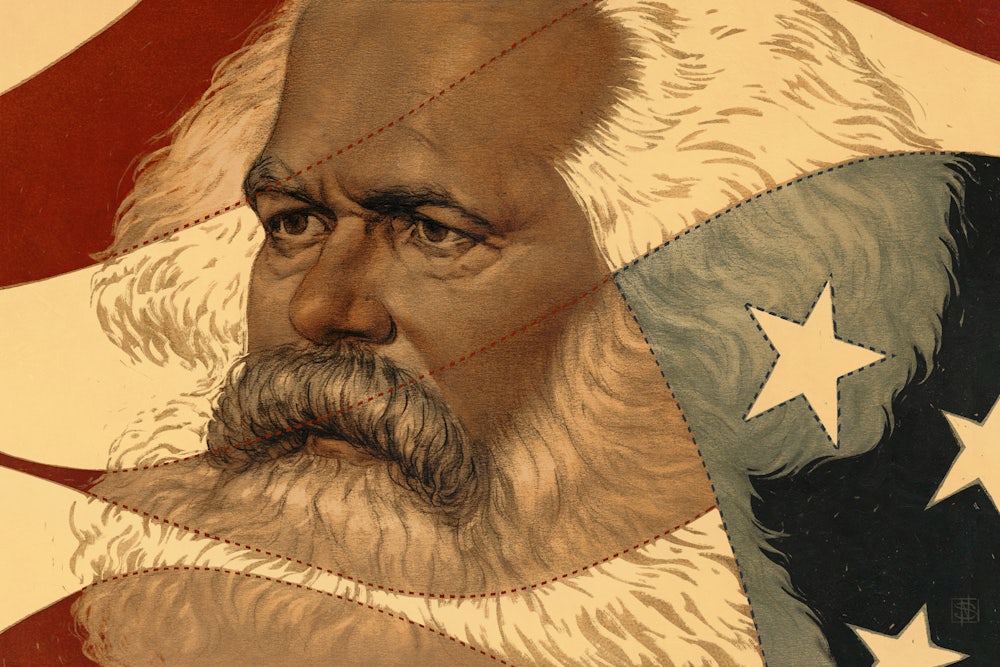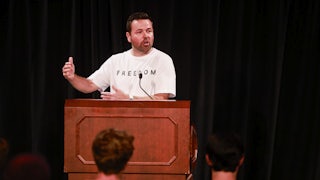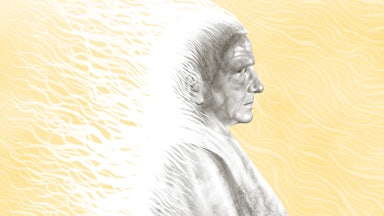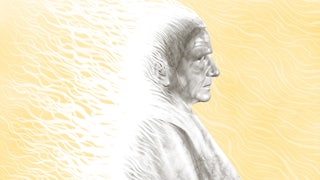The young cigar maker in New York City attended a few socialist meetings in the 1870s. But he longed to hear “constructive” ideas about how to achieve a better life for himself and his fellow workers. Then an older craftsman, who was a veteran of the European left, offered to take him through “something tangible” that “will give you a background philosophy.” That something was The Communist Manifesto.
The document, recalled his untutored protégé, “brought me an interpretation of much that before had been only inarticulate feeling.” Reading that Marx and Engels hailed “the ever expanding union of the workers” as “the real fruit” of class struggle encouraged him to organize a durable labor movement. After the ambitious cigar worker left his rolling bench to become a full-time union leader, he would always be suspicious of intellectuals, socialist or otherwise, who believed they had a duty to tell wage earners how to liberate themselves. All his life, he adhered, in effect, to Marx’s 1864 motto, “The emancipation of the working classes must be conquered by the working classes themselves.”
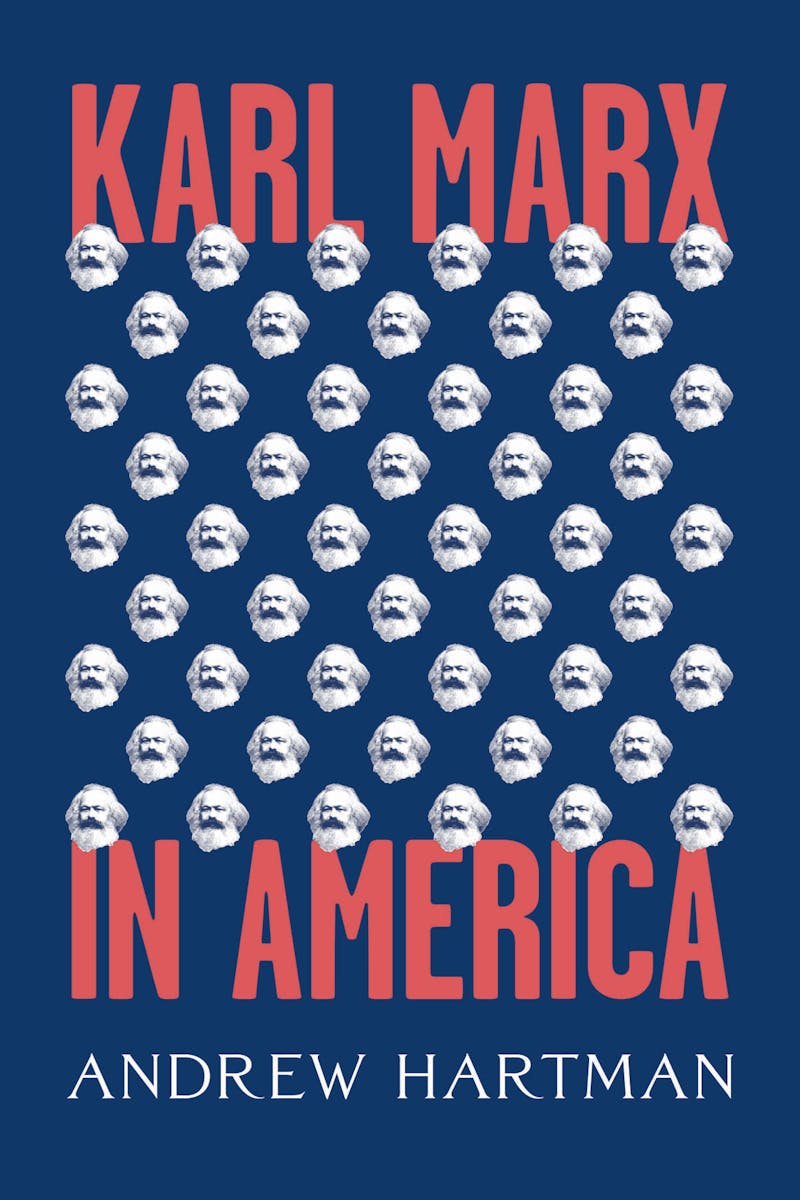
That erstwhile cigar maker was Samuel Gompers, founder and longtime president of the American Federation of Labor—the organization that evolved into the AFL-CIO and has dominated American unionism for well over a century. Gompers became a harsh critic of Marxian radicals: He thought their desire to yoke the labor movement to the fate of a socialist party would violate the independence of unions and lead them into a dead end of sectarianism, repression, and defeat.
Still, the inspiration the young Gompers drew from the Manifesto appears to support the argument Andrew Hartman makes in his sprawling, often provocative new survey, Karl Marx in America: “Marx gained purchase in American life because he offered a powerful theory of freedom—one that doubled as a map of an alternative American future.” If the bearded German icon left a strong imprint on organized labor—the movement he believed would be pivotal to overthrowing capitalism—then it must have shaped the views of millions of ordinary Americans who burned to change their society in fundamental ways.
Hartman sweeps with gusto through over a century and a half of U.S. history, revealing the influence of Marxism on dozens of institutions, individuals, and events, obscure and famous. Did you know that the revolutionary sage wrote or co-wrote nearly 500 articles for the New-York Tribune during the Civil War era, when it was one of the most popular newspapers in the nation? Or that at least two of his disciples were officers in the Union Army? Or that Franklin D. Roosevelt’s “political philosophy rhymed with Marxism”? While Hartman might overstate the importance of these political details, he largely succeeds at a different, if lesser, mission: to narrate how vital arguments about Marxist thought were to men and women who spent their lives battling about ideas.
For two distinct clusters of well-educated Americans, Marxism has long been a fruitful subject— either a set of ideas to think with or a cudgel to wield against ideological foes. In the first camp are radical and reform-minded intellectuals who take Marx’s ideas seriously—even as they ceaselessly dispute, revise, and apply them to explain the evolving forms of American culture, economics, and politics. In the second camp thrive officeholders and propagandists on the right. For them, the old Rhinelander’s name and a crude or false version of his doctrines serve as a perennial bogeyman to scare the public away from a welfare state and movements on the left. The Trump administration’s recent vow to cancel federal funding that allegedly promotes some evil known as “Marxist equity” fits a line of attack that has been around since Lenin occupied the Kremlin.
Hartman’s treatment of both left literati and right-wing witch-hunters brims with insight, cogently presented. In his most original foray into the burned-over ground of left intellectual history, he brings to life a number of thinkers about whom even most academics know little or nothing. There was Friedrich Sorge, who immigrated to New York from exile in Europe after fighting in the revolution of 1848 and “was arguably better versed in Marx’s writings” than anyone in his new country. Sorge, who helped found the nation’s first socialist party—the Workingmen’s Party of the United States—in 1876, argued that competing in elections would accomplish nothing unless wage earners first organized into powerful unions.
Although neither of the parties that flew the Marxist banner across the country in the twentieth century won more than a handful of offices beyond the local level, both the Socialist Party and the Communist Party stamped their mark on American thought and culture. The SP nurtured such writers as Jack London and Helen Keller. During his five campaigns for president on the Socialist ticket, Eugene Debs articulated the need for a “cooperative commonwealth” in terms borrowed from the Bible as well as the gospel of historical materialism. And while American Communists never abandoned their fealty to the tyrannical rulers of the Soviet Union, they did inspire such famous critics of class oppression and white supremacy as Woody Guthrie, Dorothea Lange, and Angela Davis.
Among the more obscure figures whom Hartman profiles is Raya Dunayevskaya, a Ukrainian émigré, who created, after World War II, a fresh variant of the old doctrine she called “Marxist humanism.” Her aim was to rescue a philosophy of human liberation from the Communists who had converted it into “the theory and practice of enslavement.” Together with the great Trinidadian writer and organizer C.L.R. James, Dunayevskaya argued that Marx had sharply criticized all forms of labor under capitalism—enslaved or waged—as assaults on individual freedom. Departing from an orthodox focus on white industrial wage earners allowed them to broaden the definition of the exploited to include women, racial minorities, and students. “Her Marxist theory of revolution was tailored for the 1960s,” Hartman aptly observes. But the radical feminists who coined the phrase “the personal is political” grasped the same insight without seeking legitimacy in Marx’s Economic and Philosophical Manuscripts of 1844.
Both James and Dunayevskaya arrived in the United States in the 1920s, before the Great Depression, when Marxists of all stripes understandably viewed that long downturn as proof of the chaos and misery endemic to capitalism. Surely, Americans would be open to a theory that would now seem like common sense. Organizers who happened to be Communists or Socialists played a major role in mobilizing the big strikes that birthed the unions of the Congress of Industrial Organizations in the factories where cars, steel, and refrigerators were made: Members of the Communist Party were the chief architects of the sit-down strike in Flint, Michigan, during the winter of 1936–1937 that established the United Auto Workers as a power in the land.
Yet Marxists gained more influence among writers and artists in the 1930s than among ordinary people. For all their fervor, leftist intellectuals struggled to understand why their message often failed to resonate more widely. At the polls, workers spurned Marxist candidates in favor of those from the party of Franklin D. Roosevelt, the patrician-turned-populist. One worker acclaimed FDR as “the only man we ever had in the White House who would understand that my boss is a sonofabitch.” Bowing to reality, Socialist and Communist organizers narrowed their goals to union recognition, job security, and higher wages instead of a society run by and for the working class.
The larger message of Marxism wasn’t getting through: As Hartman remarks, “Either there was something wrong with their theory, or there was something wrong with the working class.” The literary critic Kenneth Burke argued that paying closer attention to how Americans actually talked about their problems could help Marxists appeal to them in terms they might grasp. Poetic discourse, he mused, would advance the class struggle better than alien-sounding jargon. In his landmark 1935 history of the Civil War and Reconstruction, W.E.B. Du Bois hailed Black people for engaging in the biggest “general strike” in U.S. history when they fled to Union lines, depriving Confederate planters of their labor. If white workers had only shed their racial privilege, he contended, they could have forged a potent alliance across the color line. Alas, “not enough … were familiar with Capital,” Hartman says, and so they embraced the new Jim Crow order.
Du Bois remained a Marxist all his life, but some talented younger leftists soon abandoned their faith in what they took to be a failed theory and became liberal proponents of American exceptionalism. In his immensely popular 1948 book, The American Political Tradition, the historian Richard Hofstadter maintained, a bit sadly, that radical dissenters had never made much headway against a consensual culture that was “intensely nationalistic and for the most part isolationist … fiercely individualistic and capitalistic.”
Whereas the Marxists of the ’30s and ’40s may have failed to convert the working class, their successors in the ’80s and ’90s didn’t even attempt as much. As conservatives from Ronald Reagan to Donald Trump tore away at the legacies of the New Deal, the Great Society, and the New Left, American Marxism entered a newly insular phase. A number of scholars took refuge in spinning out new versions of Marxism whose only audience was inside academia. The literary theorist Fredric Jameson sought to unmask the alienating function of “commodity fetishism” with “real thought” that “demands a descent into the materiality of language and a consent to time itself in the form of the sentence.” Hartman aptly comments, “Cultural theory made a fetish of difficult language.” In their tome Empire (2000), Michael Hardt and Antonio Negri aimed to give left anti-globalizers an updated version of The Communist Manifesto but managed only to float an abstract hope that “the multitude’s ultimate demand for global citizenship” would be realized through discrete acts of resistance in locations scattered around the world. “While the Right has been busy taking the White House,” Todd Gitlin quipped about such fanciful notions, “the left has been marching on the English department.”
Since the Great Recession, young activists on the left have turned to a more demotic style of Marxism to make sense of economic inequality as well as to protest it. Hartman points to the “maximally accessible” prose in Jacobin, the magazine founded in 2010 by Bhaskar Sunkara, and to podcasts like Chapo Trap House, in which “more than a hint of Marxism” flavors relentless put-downs of deluded liberals. This new generation has failed to gain more than a few slivers of political power: Its electoral victories in Washington have been limited to a handful of candidates endorsed by the Democratic Socialists of America, notably Alexandria Ocasio-Cortez and Rashida Tlaib, and the increased prominence of Bernie Sanders. To paraphrase the famous line chiseled on Marx’s gravestone in London’s Highgate Cemetery: American Marxists have only analyzed the world in various ways; the point, however, is to change it.
Unfortunately, Hartman doesn’t capture why Marxists have found difficulty in spreading the word in the United States, and often claims victories for his cherished tradition when the story is more complicated. Take the example of Samuel Gompers. What the AFL leader learned from Marx convinced him to oppose the political strategy adopted by American Marxists. A socialist attorney once called Gompers “the most class-conscious man I know.” But that mindset drove the labor leader to avoid using socialist rhetoric or making big promises about destroying capitalism. He knew such stances would turn off most working men and women in his nation, who demanded higher wages and better treatment on the job—not a proletarian revolution.
What was true of labor was even more the case for other movements on the American left whose adherents were drawn from a variety of classes. From abolitionism to the heyday of the civil rights crusade in the 1960s, most Black organizers sought legitimacy and inspiration from such texts as the Bible and the Declaration of Independence—not the words of the Manifesto. Few feminists who were not also socialists took their cues from a nineteenth-century patriarch who wrote little about women besides noting the cheap labor they provided to factory owners. And environmentalists who yearn to do away with fossil fuels know the Soviet regime that made Marxism its state religion developed some of the filthiest carbonized industries on Earth.
Even those prominent American activists who did praise what Marx wrote—who included Martin Luther King Jr. in his grad-uate student days—did not employ his language or endorse his ideas as they built powerful social movements. The “freedom” from class exploitation that Hartman heralds was not the type that motivated many Americans, other than those who joined a socialist or communist party. And the membership and electoral clout of their organizations paled beside those of parties inspired by Marxism in nearly every other industrial nation.
Through most of U.S. history, influential dissenters have spoken in registers more indigenous to the republic—democratic, Christian, and populist. “The people” was a more common, inclusive term than “the working class,” and urgent calls to realize the promise of self-government resonated far more widely than stern attacks on the power of the homegrown “bourgeoisie.” “To make everything depend upon economic forces,” wrote the progressive thinker Richard T. Ely in 1894, “is shutting one’s eyes to other forces, equally great and sometimes greater.” He added, “one must be blind to historical and actual phenomena who would make religion merely a product of economic life.” Hartman tends to disparage this tradition as “moral leftism,” but it has been a major driver of nearly every insurgency of consequence in U.S. history.
For the right, however, the M-word has long proved an effective weapon in its perpetual war against anyone branded as enemies of liberty and the nation itself. This assault began during the presidency of FDR. “So help me God,” Father Charles Coughlin vowed in 1936 to his huge radio audience, “I will be instrumental in taking a Communist from a chair once occupied by Washington.”
But invocations of Marx became routine during the Red Scare after World War II and have rarely been absent since then. Senator Joseph McCarthy denounced a “religion of immoralism … invented by Marx … and carried to unimaginable extremes by Stalin.” Reagan gave Richard Nixon some advice about how to campaign in 1960 against his Democratic opponent for the presidency: “Shouldn’t someone tag Mr. Kennedy’s bold new imaginative program with its proper age? Under the tousled boyish haircut is still old Karl Marx—first launched a century ago.” In recent years, Trumpist hacks with big followings gleefully slap the label “cultural Marxism” onto any phenomena they detest, from critical race theory to teachers’ unions to the alleged bias of the liberal media. In a 2021 book, the talk-show jockey Mark Levin called on all Americans “who love their country, freedom, and family” to fight back against Marxists who “pursue a destructive and diabolical course for our nation, undermining and sabotaging virtually every institution in our society.”
What makes such attacks plausible to millions of Americans was—and remains—the public’s ignorance of what Marx actually wrote and believed. Hartman takes pains to show that both liberal critics and right-wing demonizers got his favorite thinker terribly wrong. He argues, with persuasive quotations, that Marx was opposed to neither free speech nor democracy, and thus the tyrannical regimes run by his would-be followers would have appalled him. But if far more Americans think Castro, Stalin, and Mao were genuine Marxists than will ever read a page of Capital, The Economic and Philosophical Manuscripts, or even the Manifesto, that is just further proof of the small impression his American disciples have made on their fellow citizens.
Despite the right’s hostility, some of Marx’s ideas still have great value almost 150 years after he died. As I wrote in these pages back in 2016, Marx “brilliantly captured the propulsive dynamic” of the capitalist economy that has now conquered the entire world. What’s more, “our credulous addiction to the magical little computers in our pockets and purses demonstrates the wisdom of the section about ‘the fetishism of commodities’ in the first volume of Capital.” Anyone who cares about the multiple injuries of class can also learn from Marx’s thorough dissection of the system of labor and production that generates so much wealth and so much pain.
Yet, at the core of his thought is the determination that capitalism, like all earlier forms of class society, will inevitably fall victim to its own contradictions. After helping dig its grave, proletarians will begin to construct a world of caring and abundance for all. In 1938, George Orwell wrote that “to the vast majority of people, Socialism means a classless society, or it means nothing at all.” But the gospel of self-reliance and the unions that struggle mainly for better pay and shorter hours have appealed to far more Americans than has the future predicted by Marx and echoed by his disciples. In the twenty-first century, a lot more working women and men have been willing to vote for an authoritarian billionaire who relishes destruction of the welfare state than have rallied to gain a measure of economic power for themselves. A theory that does not unravel that contradiction can do little to defeat Trumpism or build a more egalitarian society for Americans or anyone else.
